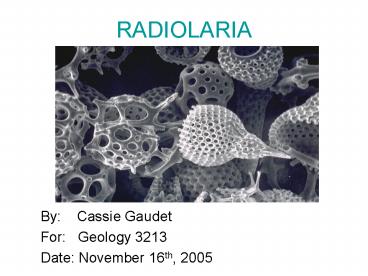RADIOLARIA - PowerPoint PPT Presentation
1 / 18
Title:
RADIOLARIA
Description:
Title: Slide 1 Author: 061279g Last modified by: 061279g Created Date: 11/2/2005 8:26:19 PM Document presentation format: On-screen Show Company: Acadia University – PowerPoint PPT presentation
Number of Views:775
Avg rating:3.0/5.0
Title: RADIOLARIA
1
RADIOLARIA
- By Cassie Gaudet
- For Geology 3213
- Date November 16th, 2005
2
Outline
- What are Radiolarians?
- ? Where they occur, What they eat
- Classification
- ? Polycystines, Phaeodarians
- Evolution
- Geologic Importance
- Reproduction
- References
3
What are Radiolarians?
- marine free-floating plankton
- can range from 30um to 2mm in diameter
- arm-like extensions are used for buoyancy and to
capture prey. - They can exist both as individuals or in
colonies.
4
What are Radiolarians? contd
- There are no recorded benthic species.
- Radiolarians often form symbiotic relationships
with algae and dinoflagellates.
5
Where they occur
- occur in all oceans, shallow seas, bays, fjords
- most abundant in the upper few hundred meters of
oceans, but found in deep trenches of the Pacific - max concentrations of Radiolarians associated
with max chlorophyll. Possibly necessary for
survival. - Radiolarian species are
- most diverse at the
- equator, lowest at the
- poles.
6
What Radiolarians eat
- Radiolarian diet includes eating zooplanktons
such as copepods, crustacean larvae, ciliates,
and flagellates. Also, - phytoplankton such as diatoms,
coccolithophores, and dinoflagellates. - They also consume bacteria and organic
detritus. - They act as both particle feeders and
predators.
7
Classification
- In 1980 Levine proposed this hierarchy
- Kingdom Protista
- Phylum Sarcomastigophora
- Subphylum Sarcodina
- Superclass Actinopoda
- Class Radiolaria
8
Classification contd
- A major problem with radiolarian classification
is that separate classifications have been
established for the Palaeozoic, Mesozoic and
Cenozoic, and little has been done to integrate
them - Though many fossils have been found, scientists
still have not been able to successfully develop
a complete classification scheme for them.
9
Groups
- Two major groups
- 1) the Polycystines, with solid skeletal elements
of opaline silica. - 2) the Phaeodarians, with organic composition
that results in rapid dissolution in sea water
and so are rarely preserved.
10
Polycystines
- have solid skeletal elements of simple opaline
silica - are subdivided into two major groups the
basically spherical-shelled Spumellaria, and the
basically conical-shelled Nassellaria. - They are wholly marine, the most commonly
- preserved and therefore most studied members
- of the Subclass Radiolaria.
-
-
11
(No Transcript)
12
Phaeodarians
- hollow skeletal elements of siliceous composition
that results in rapid dissolution in sea water
and consequent rare preservation in sediments - have a mass of pigmented cells called phaeodium
13
Evolution
- Oldest recorded occurrences of Radiolaria are
from the latest Pre-Cambrian - During the late Paleozoic Radiolaria show a
gradual decline until the end of the Jurassic
when there is a rapid diversification because of
the dinoflagellates - Evolution of diatoms in the Cretaceous had a
significant effect on radiolarian evolution -
competition for silica - Radiolarian skeletons have become finer and less
robust from this time.
14
Geologic Importance
- Unusually long geologic range from latest
Pre-Cambrian until Recent - Radiolarian assemblages often contain 200-400
species - useful biostratigraphic and palaeoenvironmental
tools
15
Geologic Importance contd
- Because Radiolaria have silica skeletons and long
geological range they are useful in the study of
sediments which lack calcareous fossils - Cherts and nodules within chert bands are often
good sources for Radiolaria. - Ophiolites and accretionary terrains often
include chert bands and Radiolaria may be the
only palaeontological aid available
16
Reproduction
- Asexual reproduction occurs in Radiolarians. Cell
division occurs in the nucleus. The test splits,
and is rebuilt by the new organism. It is
believed that sexual reproduction occurs as well,
but this has not been confirmed.
17
Radiolarian-Diatom siliceous ooze
18
References
- Radiolaria.Org
- http//www.radiolaria.org/what_are_radiolarians.h
tm - Berkeley
- http//www.ucmp.berkeley.edu/protista/radiolaria/
rads.html - Kenyon College
http//biology.kenyon.edu/Microbial_Bioreal
m/eukaryotes/radiolaria/radiolaria.html































